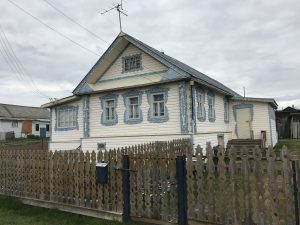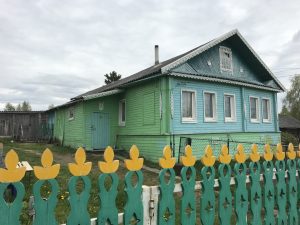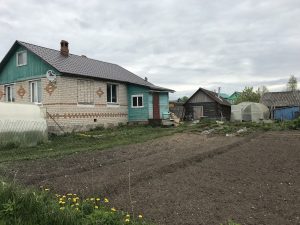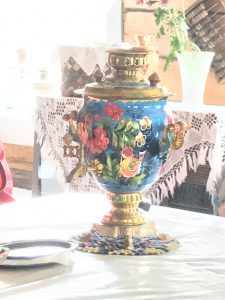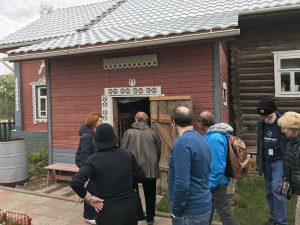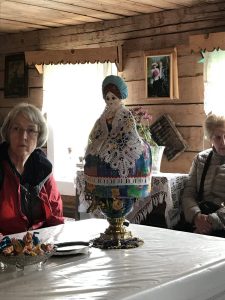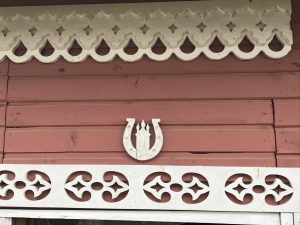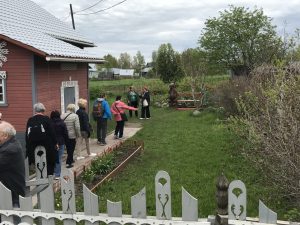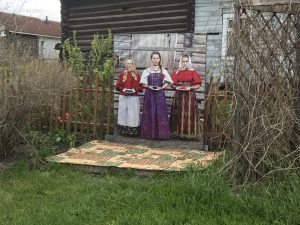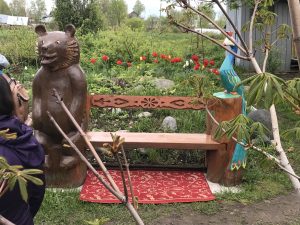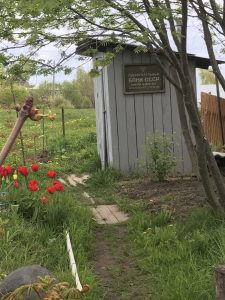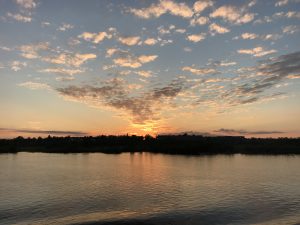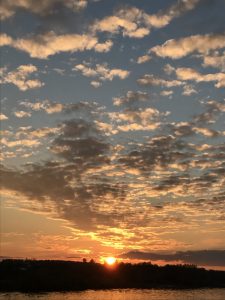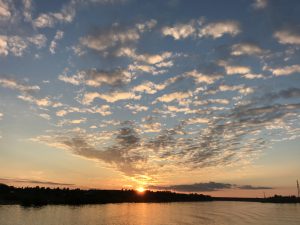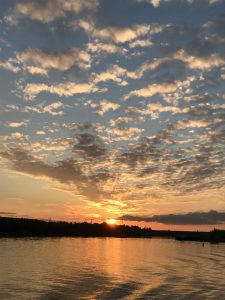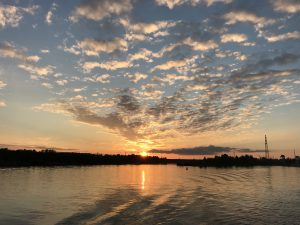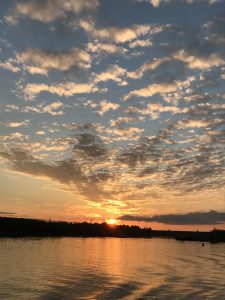Imperial Waterways of Russia
Tuesday, June 6
Goritsky and Kirillov
Wouldn’t you know it? On a day when we would cruise through the morning, moving further south through the canal, we woke up early. Really early. That meant we both went down a level to the 24-hour coffee station and looked through the official pictures of the trip so far before the dining room opened for a real breakfast. And a real breakfast it was, indeed. After the blini demonstration the afternoon before, we had enjoyed blinis with fruit fillings during the rest of tea time, and we had been told that caviar was often served with blinis. To our surprise, the breakfast buffet this morning included blinis, black caviar, and champagne. Judy was all smiles as she took full advantage of this opportunity, and I’m only sorry I don’t have a photo.
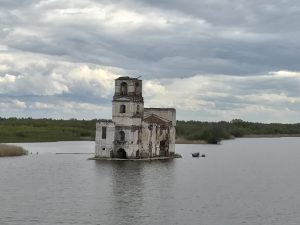 Because of the timing of our shore visit, the history lecture was in the morning this time, and we were treated to a great explanation from the inside, so to speak, of the events that led up to the end of the Soviet era in the early 1990s. It was really fascinating to hear about events we remembered from the other side. One little fact I wrote down: Today 60% of Russians regret the loss of social security benefits of the Soviet era, but only 6% want Communism and a Soviet society to return. Interesting. As it turns out, I would get a personal report of that later in the day. Another interesting point: Dr. Gritsenko interrupted her talk as the ship made a detour to circle the ruins of a church. The village below had been flooded when dams and the resultant canal linked Lake Onega with the Volga River to the south.
Because of the timing of our shore visit, the history lecture was in the morning this time, and we were treated to a great explanation from the inside, so to speak, of the events that led up to the end of the Soviet era in the early 1990s. It was really fascinating to hear about events we remembered from the other side. One little fact I wrote down: Today 60% of Russians regret the loss of social security benefits of the Soviet era, but only 6% want Communism and a Soviet society to return. Interesting. As it turns out, I would get a personal report of that later in the day. Another interesting point: Dr. Gritsenko interrupted her talk as the ship made a detour to circle the ruins of a church. The village below had been flooded when dams and the resultant canal linked Lake Onega with the Volga River to the south.
But I get ahead of myself.
This was the only day where Judy and I chose to do different things. our stop in the afternoon was at Goritsy, or Goritsky as our onboard publications had it, a village along the Volga-Baltic Canal. My guess is you’ve never heard of it in either spelling, and, no surprise, neither had we. For good reason. it’s a small village, not a real town, whose main claim to fame seems to be it’s on the canal, has a dock, and it’s not too far from Kirillov. Another place you’ve probably never heard of, right? Well it turns out that the Kirillov Monastery is historically important, and is now an active establishment with a forward looking school that we could visit. Judy decided to take the bus to visit the Kirillov Monastery, while I opted to stay in Goritsy and make a visit to one of the local homes there.
To no one’s surprise, Judy enjoyed the visit as much for the children they saw as for the chance to visit an important historic location. After all, as she said, we’ve seen lots of monasteries, and we had already visited a number of Russian Orthodox church buildings of one kind or another. She did enjoy seeing the bells, of course, though she didn’t really get to hear them. But children who are well-rehearsed and primed to perform for visitors are the same the world over. There are clowns, show-offs, and shy ones. And they are all charming. If I can convince her to do it, she’ll add her comments here later.
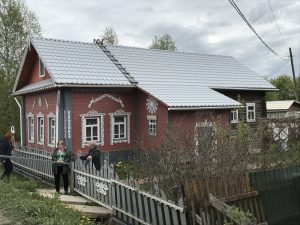 My home visit in the village was enlightening. Seriously enlightening. We went to the home of a senior couple who had met and married later in life (Galinka and Leonid Minkin), a second marriage for each of them, former professionals who had been two of the many who had incurred losses with the fall of the USSR. They had returned to Goritsy to live in her parents’ former home just to survive. Like many homes in the village, they had an outhouse, electricity in at least part of the building, and running water inside the home solely because Leonid had worked to install a pump and drain system from the well beside their home. Their outhouse had a sign on it that proclaimed “Deposits to the USSR Bank.” It was fascinating to listen to them answer questions that were at times intrusive, and to see how many aspects of their home life looked so familiar. Except for the treasured samovar in the middle of the table. That wasn’t something we had on tables in Possum Bend.
My home visit in the village was enlightening. Seriously enlightening. We went to the home of a senior couple who had met and married later in life (Galinka and Leonid Minkin), a second marriage for each of them, former professionals who had been two of the many who had incurred losses with the fall of the USSR. They had returned to Goritsy to live in her parents’ former home just to survive. Like many homes in the village, they had an outhouse, electricity in at least part of the building, and running water inside the home solely because Leonid had worked to install a pump and drain system from the well beside their home. Their outhouse had a sign on it that proclaimed “Deposits to the USSR Bank.” It was fascinating to listen to them answer questions that were at times intrusive, and to see how many aspects of their home life looked so familiar. Except for the treasured samovar in the middle of the table. That wasn’t something we had on tables in Possum Bend.
Dinner that evening was interrupted when we look out the window. What a sunset! Dave Chalmers and I both jumped up, went out on the deck and made shot after shot. A glorious scene for the end of the day.
Depending on the device you are using, you might have to scroll down a bit to get to the photos and a special treat: a video of our departure from Goritsky.
When we met back up at the ship, and preparations were being made for our departure, we were ready for something we had noticed the day before: When Russian ships leave port, they play music through the sound systems. How cool is that? When we left Kizhi Island the day before, Judy and I had stopped out onto our little balcony and heard a really neat song being played, one we didn’t know. I grabbed the closest phone this time, just to be ready, but I was a little late in getting started. The captain chose “I Believe,” from Davd Koz’s album Saxophonic. Check it out. I do wonder if the captain had heard one of his concerts during the Dave Koz tour the week or so earlier. Whether or not he did that, he must be a fan. By the way, the monastery you see in the video is really a convent in Goritsky, one of only four religious institutions for women in Russia.



